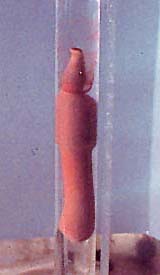
|
Echiurans were included in the Annelida
until recently, and they are still considered close relatives of the annelids.
The body of an echiuran lacks annelid-type segmentation,
but the distinctive free-swimming trochophore larval stages of
echiurans and polychaetes are very similar. Both echiurans and annelids are
classified together within a larger group, the Trochozoa.
Echiurans have an extensible proboscis and a set of small hooks at the
posterior end; hence the Latin name of the phylum, "spine-tails." In English,
echiurans are referred to as "spoon worms" (when referred to at all).
Although there are only about 150 species of echiurans known today, they are quite common in some marine environments. Urechis caupo, the "innkeeper worm" pictured here, is common in some mudflats of the Pacific coast of California. Normally it inhabits a U-shaped burrow; it is shown here in a glass tube, in a laboratory experiment on feeding. The mucus net which it creates with its proboscis is just visible; the worm filters water through its burrow and traps planktonic organisms in this net. This is an unusual mode of feeding for echiurans, and most use their proboscises to move sedimentary detritus to their mouths. Urechis is known as the "innkeeper worm" because a number of marine organisms, including small crabs, polychaete worms, and fish, live as commensals inside the echiuran's burrow. U-shaped burrows are known in the fossil record from Cambrian times. Some of these trace fossils may have been made by echiurans, but a number of other organisms make very similar burrows. Body fossils of echiurans are much rarer, since echiurans have no hard parts. The oldest plausible echiuran fossil is Pennsylvanian. |


